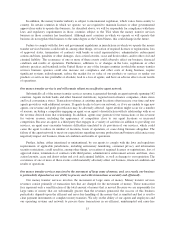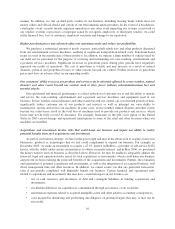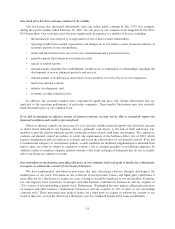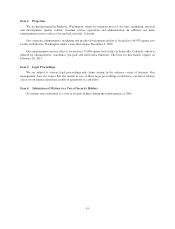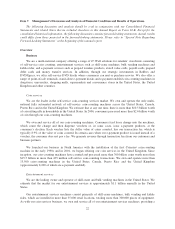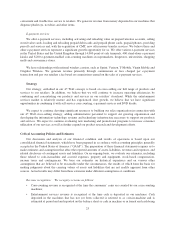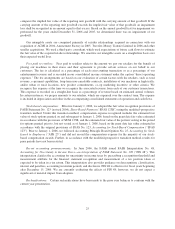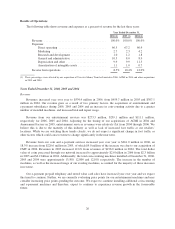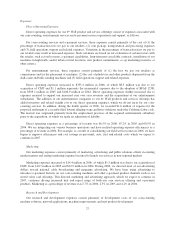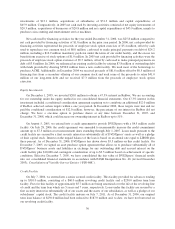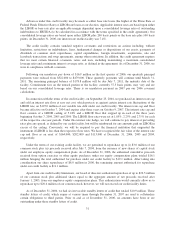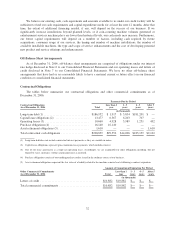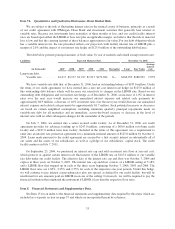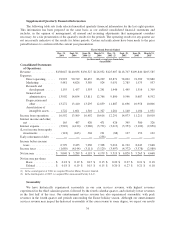Redbox 2006 Annual Report Download - page 27
Download and view the complete annual report
Please find page 27 of the 2006 Redbox annual report below. You can navigate through the pages in the report by either clicking on the pages listed below, or by using the keyword search tool below to find specific information within the annual report.compares the implied fair value of the reporting unit goodwill with the carrying amount of that goodwill. If the
carrying amount of the reporting unit goodwill exceeds the implied fair value of that goodwill, an impairment
loss shall be recognized in an amount equal to that excess. Based on the annual goodwill test for impairment we
performed for the years ended December 31, 2006 and 2005, we determined there was no impairment of our
goodwill.
Our intangible assets are comprised primarily of retailer relationships acquired in connection with our
acquisition of ACMI in 2004, Amusement Factory in 2005, Travelex Money Transfer Limited in 2006 and other
smaller acquisitions. We used a third-party consultant, which used expectations of future cash flows to estimate
the fair value of the acquired retailer relationships. We amortize our intangible assets on a straight-line basis over
their expected useful lives.
Fees paid to retailers: Fees paid to retailers relate to the amount we pay our retailers for the benefit of
placing our machines in their stores and their agreement to provide certain services on our behalf to our
customers. The fee is calculated as a percentage of each coin-counting transaction or as a percentage of our
entertainment revenue and is recorded in our consolidated income statement under the caption “direct operating
expenses.” The fee arrangements are based on our evaluation of certain factors with the retailers, such as total
revenue, e-payment capabilities, long-term non-cancelable contracts, installation of our machines in high traffic
and/or urban or rural locations, new product commitments, co-op marketing incentive or other criteria. We
recognize this expense at the time we recognize the associated revenue from each of our customer transactions.
This expense is recorded on a straight-line basis as a percentage of revenue based on estimated annual volumes.
In certain instances, we prepay amounts to our retailers, which are expensed over the contract term. The expense
is included in depreciation and other in the accompanying consolidated statements of operations and cash flows.
Stock-based compensation: Effective January 1, 2006, we adopted the fair value recognition provisions of
FASB Statement No. 123 (revised 2004), Share-Based Payment (“SFAS 123R”) using the modified–prospective
transition method. Under this transition method, compensation expense recognized includes the estimated fair
value of stock options granted on and subsequent to January 1, 2006, based on the grant date fair value estimated
in accordance with the provisions of SFAS 123R, and the estimated fair value of the portion vesting in the period
for options granted prior to, but not vested as of January 1, 2006, based on the grant date fair value estimated in
accordance with the original provisions of SFAS No. 123, Accounting for Stock-Based Compensation (“SFAS
123”). Prior to January 1, 2006, we followed Accounting Principle Board Opinion No. 25, Accounting for Stock
Issued to Employees (“APB 25”) and did not record the compensation expense for the majority of our stock-
based compensation awards. Further, in accordance with the modified-prospective transition method, results for
prior periods have not been restated.
Recent accounting pronouncements: In June 2006, the FASB issued FASB Interpretation No. 48,
Accounting for Uncertainty in Income Taxes—an interpretation of FASB Statement No. 109 (“FIN 48”). This
interpretation clarifies the accounting for uncertainty in income taxes by prescribing a recognition threshold and
measurement attribute for the financial statement recognition and measurement of a tax position taken or
expected to be taken in a tax return. This interpretation also provides guidance on derecognition, classification,
interest and penalties, accounting in interim periods, and disclosure. FIN 48 is effective for fiscal years beginning
after December 15, 2006. We are currently evaluating the effects of FIN 48; however, we do not expect a
significant or material impact from adoption.
Reclassifications: Certain reclassifications have been made to the prior year balances to conform with the
current year presentation.
25


